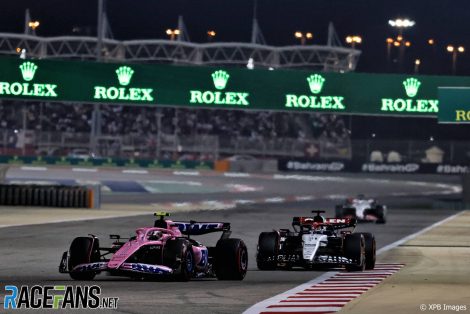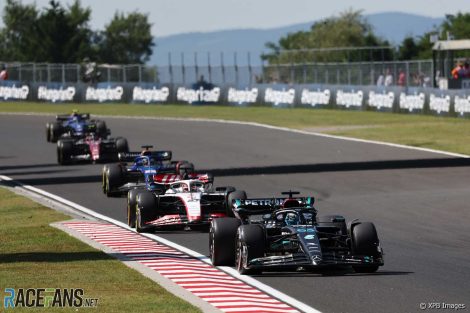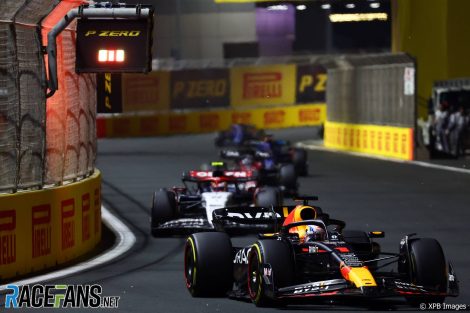The driver who pulled off the biggest climb through the field in 2023 had more than a little luck on his side.
Sergio Perez’s climb from last on the grid to fifth at the chequered flag in the Australian Grand Prix hung on a contentious decision by the race director about the restart order before the field took the chequered flag behind the Safety Car.While the Red Bull drivers enjoyed a significant advantage when it came to charging through the field, several surprising names from the midfield appear among the drivers who made the best recovery drives of the year.
In total, there were 12 occasions where a driver finished a grand prix 10 places or more above their starting position.
=10. Sergio Perez, Qatar Grand Prix, 10 positions

When racing resumed he went down the order as Mercedes’ George Russell passed him, then sat behind Zhou Guanyu before eventually overtaking him on lap 15 of 57. However Perez soon earned a five-second penalty for track limits abuse, which he had the option of serving during a pit stop. Once he did that he sat in 12th place, and his progress was stalled by another track limits penalty which he served during his third pit stop. It left him 13th with 13 laps to go.
The last pit stops of Zhou and Alexander Albon meant Perez gained two spots, and despite getting yet another track limits penalty that was applied post-race he climbed two places higher in the final classification due to penalties for others. In total he made one overtake all race that stuck.
=10. Zhou Guanyu, Qatar Grand Prix, 10 positions

A long opening stint meant Zhou spent more than a third of the green flag laps prior to his first pit stop in fourth place. That trip to the pits dropped him all the way back down to 17th, and he needed to make two more stops due to a one-off rule the FIA introduced for the weekend that limited drivers to 18 laps on each set of tyres.
Zhou made it back to fourth again before his second stop, then rose from 15th to sixth in his next stint. Doing the mandatory third stop left him down in 12th in the results, but he had driven cleanly and reaped the benefits post-race to be classified ninth when track limits penalties came into play.
Advert | Become a RaceFans supporter and
=10. Oscar Piastri, Singapore Grand Prix, 10 positions

Piastri gained three places on the opening lap then stayed there until he joined most of the field in pitting when the safety car came out. On the restart he passed Valtteri Bottas for 12th but did not gain any further ground until the race’s second half when Pierre Gasly – the car he had been behind – starting picking off drivers and Piastri followed him through. That progress ended in eighth place, but he gained one more spot when Russell crashed out on the last lap.
9. Pierre Gasly, Bahrain Grand Prix, 11 positions

On race day he only made up two places before his first pit stop, but he made up for that once he was on the hard compound tyres as he charged up to 12th on his first stint with them and then to 11th in his second stint.
He returned to soft tyres for his final stint, and rose to ninth by timing his pit stop to be during a virtual safety car period, and then held position to the finish.
Advert | Become a RaceFans supporter and
=5. Sergio Perez, Austrian Grand Prix, 12 positions

He overtook Bottas on lap one of the grand prix, gained another spot from Kevin Magnussen pitting, then after an early safety car period passed three drivers. Prolonging his first stint meant he rose up to third, but was passed by Carlos Sainz Jnr – who had already pitted – so was in fourth when he made his first pit stop.
In his second stint he got up to second place before pitting, and that stop only dropped him to fifth. Two on-track passes after that meant he finished on the podium, 17s behind his winning team mate. Perez’s poor qualifying performance denied his team a one-two finish at their home track.
=5. Esteban Ocon, Las Vegas Grand Prix, 12 positions

He then switched to a set of hard tyres that he ran to the end, and his management of them was key to his rise to fourth place. Ocon jumped from 10th to sixth mid-race when many made their second pit stops during a brief safety car period. He later overtook team mate Gasly, despite a radio message telling him to hold position behind him, then took fourth when Piastri pitted.
On the last lap he was passed by Russell, but he had a penalty for colliding with Verstappen so Ocon gained back the place. In contrast to Ocon, Gasly did a bad job of looking after his tyres and fell from third to 11th in the race’s second half.
Advert | Become a RaceFans supporter and
=5. Lando Norris, Mexican Grand Prix, 12 positions

In the first 10 laps he gained three places, then pitting dropped him down to 18th. That was the position he remained in until lap 22, when the climb up the order finally began on his hard compound tyres. Norris gained six places in three laps, and made it into the points on lap 29. When the safety car appeared four laps later, Norris used the opportunity to pit for medium tyres and he now had to make progress from 14th.
That proved no issue, as all but one of the positions he made back up after that en route to fifth were achieved via overtakes (albeit one with the assistance of McLaren team orders) and he quickly pulled away from every driver he overtook.
=5. George Russell, Hungarian Grand Prix, 12 positions

There was some chaos at the start of the race but Russell avoided it to gain four places. Then he passed Magnussen on lap two for 13th place. There were no more overtakes after that, but he had risen to fifth by lap 21 as others pitted. The reality of his progress up the order was reflected by him falling to 14th when he pitted, but in his second stint Russell did pass rivals on-track and when he pitted from sixth he only lost two places.
After that he hunted down Carlos Sainz Jnr for seventh, then gained another spot from Sainz’s Ferrari team mate Charles Leclerc who was penalised post-race.
Advert | Become a RaceFans supporter and
=3. Max Verstappen, Saudi Arabian Grand Prix, 13 positions

Undeterred, Verstappen overtook eight drivers in the first 14 laps of the race, with rivals pitting helping him get up to fourth two laps later. Pitting under the safety car meant he lost no ground, and opting for hard tyres meant he did not need to pit again. Within five laps of racing resuming he had passed Russell and Fernando Alonso to get into second, where he finished.
=3. Lance Stroll, United States Grand Prix, 13 positions

Both Aston Martin drivers were eliminated in Q1 for the United States Grand Prix, Stroll in part due to a brake problem restricting his practice running, so the team opted to modify their cars while in parc ferme and resign them to pit lane starts.
It was a strategy that worked, with Stroll making it all the way into the points (for the first time in six race weekends) on merit and then being promoted from ninth to seventh by two disqualifications.
2. Lance Stroll, Las Vegas Grand Prix, 14 positions

Avoiding the turn one chaos meant Stroll ended the first lap in ninth, with his team mate 10 places behind after starting 10 ahead. Stroll conceded his points position on lap three by pitting under the safety car, having started on soft tyres, which left him in 15th for the lap seven restart. From there a combination of overtakes and (mostly) cars ahead pitting brought him up to second place before he made his own second pit stop, once again during a safety car period.
That contributed further to Stroll’s climb, as he sat in seventh place for the following restart. He had the pace to stay there, and with 10 laps to go passed Gasly for sixth. Two laps later Piastri pitted and Stroll was in fifth, where he stayed to the end.
Advert | Become a RaceFans supporter and
1. Sergio Perez, Australian Grand Prix, 15 positions

He gained two places on lap one despite pitting, as the safety car was out, and did the same on lap two. When racing resumed he managed to overtake two cars, before the safety car returned and the race was red flagged for the first time. For the next restart he was in 13th place, but lost three places when green flag action resumed. Nobody was set to pit again until the very end of the race, so he had to rely solely on pace to make up lost ground.
Perez climbed to seventh before the race was red-flagged again. But at the third standing start of the day he wasted his efforts by sliding off at turn one. He came back around in 10th place.
However a controversial call by the race director gave Perez his place back – and more. The race was restarted for a final lap behind the Safety Car, with no overtaking allowed, and all drivers back in their original order. That put Perez seventh initially, then he gained two places from Gasly, who had retired, and Sainz, who was penalised. His final finishing position of fifth was confirmed when the stewards reject Haas’ attempt to protest the race director’s decision.
The upshot was Perez had pulled off a 15-place climb through the field from start to finish – the biggest seen all year.
Over to you
Which recovery drive impressed you the most during the 2023 F1 season? Have your say in the comments.
Formula 1
- F1 CEO Domenicali wants more than six sprint races per year
- Hulkenberg named Audi’s first F1 driver for 2026
- Ricciardo needs to show “head-turning form” for 2025 chance – Horner
- F1 Commission defers decision on points change and approves new rear cameras
- Red Bull’s star designer Newey to leave team – reports





Facts&Stats
29th December 2023, 12:31
If you remove the abnormal low qualifying ones due penalties, track limits, or similar there is only a top three of most ‘impressive’ charges through the field:
– Zhou
– Piastri
– Ocon
Nick T.
31st December 2023, 8:28
Yup, it’s why biggest charges through field lists simply based on places made up are pointless. It should also note when drivers lucked into big positional gains like Zhou and Gasly in Zandvoort due to rain and/or safety cars. It should all be about most impressive drives through the field with some context. While not a Lando fan, I have to say I found his Mexico City GP drive the most exciting and impressive drive through the field.
Olivier
29th December 2023, 19:06
Surprise, surprise. The 2 biggest pulls through the field by the 2 drivers at the bottom of the list this site publishes.
W (@vishnusxdx)
29th December 2023, 19:39
Of course, when you have got one of the best cars of the field en STILL manage to bottle your quali, you’re still going to cut through the field like a hot knife through butter.
If you apply that reasoning further then max, hamilton and alonso must be the worst drivers on the grid. They hardly did any overtaking. Which is hard to do, when you qualify at the front, or thereabout the maximum capability of the car.
Nick T.
31st December 2023, 8:29
So, you think Checo and Stroll were impressive this season?